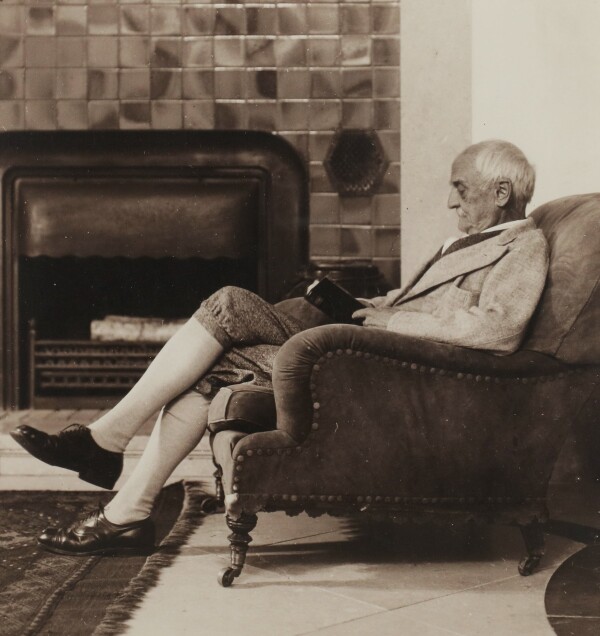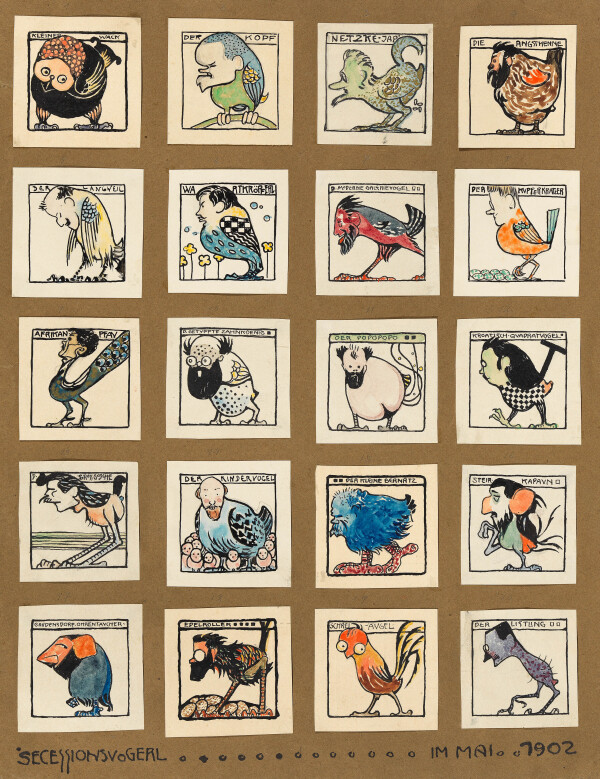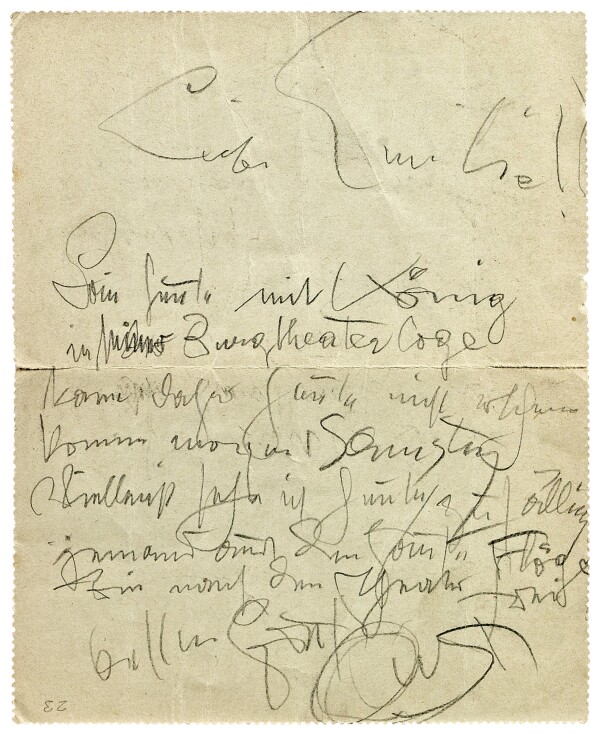Friedrich König

Friedrich König photographed by Moriz Nähr, Klimt Foundation, Vienna
© Klimt Foundation, Vienna

Friedrich König, Secession Vogerl, 1902, Kupferstichkabinett of the Academy of Fine Arts Vienna
© Graphic Collection of the Academy of Fine Arts Vienna

Gustav Klimt: Pneumatic post letter card from Gustav Klimt in Vienna to Emilie Flöge in Vienna, 01/18/1901, Leopold Privatsammlung
© Leopold Museum, Vienna
The Viennese painter and graphic artist Friedrich König was a member of the Hagengesellschaft and co-founder of the Vienna Secession. In 1902 he created the well-known “Secessionvogerl” – a collection of caricatures depicting 20 Viennese Secessionists, including Gustav Klimt, in a whimsical, bird-like form.
Friedrich König was born in Vienna in 1857. He attended the School of Arts and Crafts and the Academy of Fine Arts in Vienna. Following his training, he first went to Munich, but after some time returned to Vienna, where he was engaged, among other projects, as a book illustrator for the multi-volume work “Die österreichisch-ungarische Monarchie in Wort und Bild” [“The Austro-Hungarian Monarchy in Word and Picture”] – the so-called “Kronprinzenwerk” [“Crown Prince’s Work”].
“A secret fairytale prince and poet”
In the 1890s, Friedrich König became a leading member of the Hagengesellschaft, an association of artists regularly meeting at the Café Sperl, among other places. During their meetings the members made several hundreds of drawings and caricatures, which are now held by the Albertina and the Academy of Fine Arts. Most of these humorous works are by the hand of Friedrich König.
In 1897 the artist was involved in the foundation of the Vienna Secession. He primarily produced numerous graphic and decorative works for the exhibition catalogs and the association’s magazine Ver Sacrum, with König as a member of the “Redactions-Comité,” the editorial committee. In the exhibitions as such, König often presented prints, mythological subjects, and landscapes. The painter and graphic artist received special praise for his artistic contributions, which he presented at the “VII. Ausstellung der Vereinigung bildender Künstler Österreichs Secession” [“7th Exhibition of the Association of Austrian Artists Secession”]. On 13 March 1900, the Neue Freie Presse published the following review by the German art critic Franz Serveas:
“A new tone is introduced by Friedrich König. This is a secret fairytale prince and poet. […] In his hands, the landscape turns into a poem; imagination joins in deliciously and sweetly, offering its gifts. This time, König seems to be the most captivating figure next to Klimt among the Viennese […].”
Today König is primarily known for his so-called “Secessionvogerl,” [“Little Birds of the Secession”] which he drew in May 1902. They are a collection of small-sized caricatures depicting several members of the Vienna Secession as birds, among them Carl Moll as “The Modern Gallery Bird,” Josef Hoffmann as the “Croatian Square Bird,” and Gustav Klimt, whose animal likeness König gave the original name “The Popopopo.”
Encounter with Gustav Klimt
Several autographs are proof that Gustav Klimt and König not only collaborated as artists, but that they also regularly spent their free time together. This also continued after Klimt had left the Vienna Secession while König was still a member. They met at the Meierei Tivoli and, according to a pneumatic tube letter of 18 January 1901, went to the Burgtheater together. Moreover, it seems that around the turn of the century König also gave his colleague his tickets for concerts and theater performances on several occasions.
Commemorative Exhibition (1943)
Friedrich König died in Vienna in 1941. Two years after his death, a comprehensive commemorative exhibition was held in his and another artist’s honor at the Vienna Künstlerhaus.
Literature and sources
- Elisabeth Dutz: The Hagengesellschaft: Bohemia in Vienna, in: PhotoResearcher, Nummer 31 (2019), S. 112-133.
- Marian Bisanz-Prakken (Hg.): Heiliger Frühling. Gustav Klimt und die Anfänge der Wiener Secession 1895–1905, Ausst.-Kat., Albertina (Vienna), 16.10.1998–10.01.1999, Vienna 1999, S. 143.
- Neue Freie Presse (Morgenausgabe), 13.03.1900, S. 4.
- Neues Wiener Journal, 20.06.1929, S. 8.
- Neues Wiener Tagblatt, 08.05.1941, S. 5.
- Volks-Zeitung, 18.07.1943, S. 6.
- Rohrpost-Kartenbrief von Gustav Klimt in Wien an Emilie Flöge in Wien (18.01.1901). RL 2619, .
- Ansichtskarte von Gustav Klimt in Wien an Emilie Flöge in Steinakirchen am Forst (11.03.1916). Autogr. 959/52-3, .
- Rohrpost-Kartenbrief von Gustav Klimt in Wien an Emilie Flöge in Wien (04/18/1899). RL 2603, .
- Felix Czeike (Hg.): Historisches Lexikon Wien, Band 3, Vienna 1994, S. 566.
- Österreichische Akademie der Wissenschaften (Hg.): Österreichisches Biographisches Lexikon 1815–1950, Band 4, Vienna 1993.
- Hans Vollmer (Hg.): Allgemeines Lexikon der Bildenden Künstler von der Antike bis zur Gegenwart. Begründet von Ulrich Thieme und Felix Becker, Band XXI, Leipzig 1927, S. 148.
- Vereinigung bildender Künstler Österreichs Secession (Hg.): Katalog der I. Kunstausstellung der Vereinigung bildender Künstler Österreichs, Ausst.-Kat., Flower rooms of the k. k. Gartenbaugesellschaft (Vienna), 26.03.1898–20.06.1898, Vienna 1898, S. 7.
- Vereinigung bildender Künstler Österreichs Secession (Hg.): Katalog der IIII. Kunstausstellung der Vereinigung Bildender Künstler Österreichs Secession, Ausst.-Kat., Secession (Vienna), 18.03.1899–31.05.1899, Vienna 1899, S. 4.

